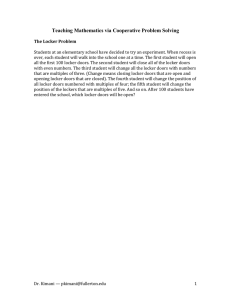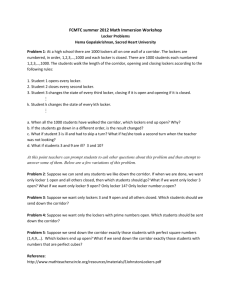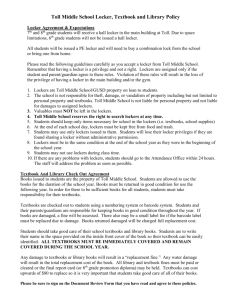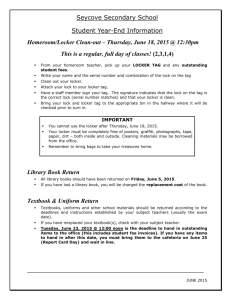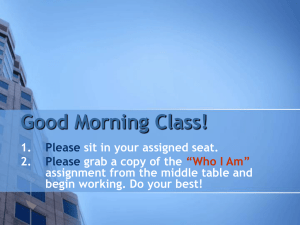Kimani PowerPoint
advertisement
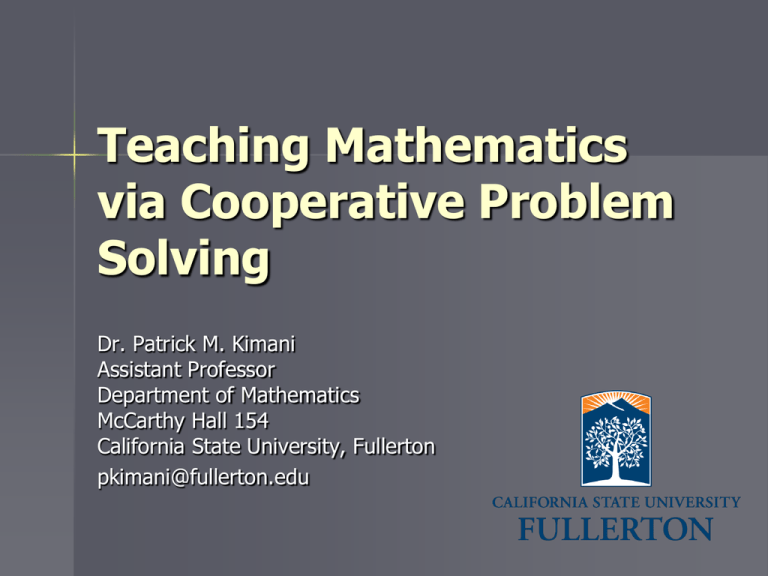
Teaching Mathematics via Cooperative Problem Solving Dr. Patrick M. Kimani Assistant Professor Department of Mathematics McCarthy Hall 154 California State University, Fullerton pkimani@fullerton.edu Overview Background Standards Activity! Discussion Reflection Background Research findings have indicated that learning occurs when students are actively involved in the learning process, by assimilating information and constructing their own meanings. Learning via problem solving is one way in which students are engaged in the learning process and have opportunities to make their own interpretations of the mathematics they are learning. Background Students are actively engaged in learning mathematics via problem solving. Learning/teaching (via problemsolving) differs from traditional teacher led approaches with regard to both the teacher’s and the students’ roles. Teaching/Learning via Traditional Approach Teaching/Learning via Problem Solving Teacher’s Role Lectures Assigns seat work Dispenses knowledge Guides and facilitates. Poses challenging questions. Helps students share knowledge. Students’ Role Works individually Learns passively Forms mainly “weak” constructions Works in a group Learns actively Forms mainly “strong” constructions. Standards California (Problem Solving) High school graduates should be able to use logical reasoning inherent in mathematics to solve practical problems with accuracy. California Standards (Problem Solving continued) … In particular students should be able to: – make decisions about how to approach problems. – use strategies, skills, and concepts in finding solutions. – determine if a solution is complete and move beyond a particular problem to generalizing the result to other situations. California Standards (Number Sense) By sixth grade students should be able to determine the least common multiple and the greatest common divisor of whole numbers; use them to solve problems with fractions (e.g., to find a common denominator to add two fractions or to find the reduced form for a fraction). Standards NCTM (Problem Solving) Instructional programs from prekindergarten through grade 12 should enable all students to: build new mathematical knowledge through problem solving; solve problems that arise in mathematics and in other contexts; apply and adapt a variety of appropriate strategies to solve problems; monitor and reflect on the process of mathematical problem solving. Activity! Form a group of 3-4 people to work together Solve the locker problem! Keep Polya’s problem solving steps in mind! The Locker Problem Students at an elementary school have decided to try an experiment. When recess is over, each student will walk into the school one at a time. The first student will open all the first 100 locker doors. The second student will close all of the locker doors with even numbers. The third student will change all the locker doors with numbers that are multiples of three. (Change means closing locker doors that are open and opening locker doors that are closed). The fourth student will change the position of all locker doors numbered with multiples of four; the fifth student will change the position of the lockers that are multiples of five. And so on. After 100 students have entered the school, which locker doors will be open? Discussion Which locker doors are open? Why are these the open lockers? Can your solution be extended to 1000 lockers? 1, 000, 000 lockers? n lockers? What mathematical ideas are in this problem? Where do we go from here? Using what you learned from the locker problem can you complete this table? Number Prime Even/Odd Exact What are Factorization Number of Number of the Factors Factors Factors? 529 23x23 126 2x3x3x7 441 3x3x7x7 169 13x13 11025 3x3x5x5x7x7 16 X 15 X 14 X 13 X 12 X 11 F 10 A 9 C 8 T 7 O 6 R 5 S 4 X X X X X X X X X X 2 X X X X X X X X X X X X 3 1 X X X X X X X X X X X X X X 2 X X X X X X X X X X X X X X X X X X X X X X X X X X 1 2 3 4 5 6 7 8 9 10 11 12 13 14 15 16 17 18 19 20 21 2 N U M B E R Number of Factors Numbers 1 1 2 2, 3, 5, 7, 11, 13, 17, 19 … 3 4, 9, 25, 49, 121, … 4 6, 8, 10, 14, 15, 21, 22, 23, 27, … 5 16, 81, 625, … 6 12, 18, 20, 28, 32, … 7 64, … 8 128, 9 256, Number of Factors Numbers (where p is prime) 1 P0 2 p1 3 p2 4 P3 or p1p2 5 P4 6 P5 or p1.p22 7 P6 8 P7, p1.p23 9 p8 or p21p22 Sample Assessment Questions How many factors does the number 23.35.72 have? Extension: What are the factors of the number 23.72 Write a number with 12 factors. Reflection Unit Objective: By the end of the unit students should be able to find the number of factors any whole number has using the fundamental theorem of arithmetic. Unit Assumption: Students have been exposed to basic factoring. References California State Standards. National Council of Teachers of Mathematics (2000). Principles and standards of school mathematics. Reston, VA: Author. Masingila, Lester, & Raymond (2006). Mathematics for Elementary Teachers via Problem Solving. Tichenor Publishing & Printing.
